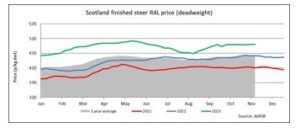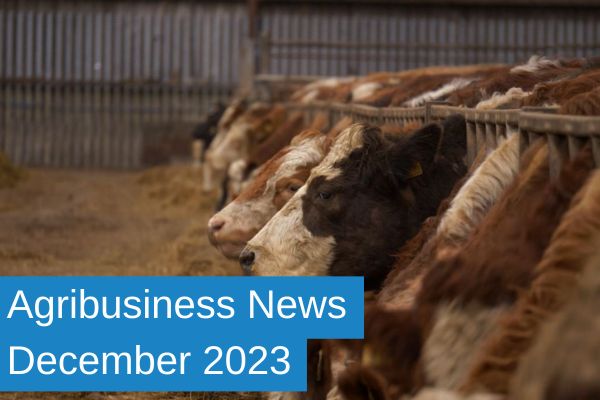Agribusiness News December 2023 – Beef
30 November 2023Beef Price Remains Static
After several weeks at 499p/kg dwt, finished beef prices have recently seen a festive uplift with R4L steers sitting at 500p/kg dwt in Scotland for the week ending November 18.
Improved retail demand as the Christmas countdown begins, is supporting prime cattle prices, with figures from QMS showing cattle and sheep prices were 20-25% above the five-year average in early November. However, with only two more weeks left for Christmas orders, it is unlikely that prices will increase significantly now and will more likely ‘stand on’ as processors look to fill retailer orders.
With numbers of prime cattle remaining fairly tight combined with early festive demand from butchers and abattoirs, several auction marts have recently reported a strong trade in the live ring as prices have increased throughout November.

Lighter Slaughter Weights
Although AHDB data estimates prime cattle slaughterings to be trending upwards, carcase weights remain lighter, with reports of leaner cattle, potentially a reflection of wet weather resulting in poorer grazing and variable silage quality.
Going forward the increasing influence of dairy beef bred animals, could contribute to a lowering of weights and cattle killing out lighter.
Cow Trade
Cow prices have started to slide seasonally, as processors focus on prime cattle. That being said trade for cull cows remains good and will possibly increase into the New Year as consumers turn to processed beef following the Christmas spend.
Worrying Trends
After starting 2023 ahead of 2022 levels, cull cow numbers coming through Scottish abattoirs fell during summer and autumn of this year suggesting that the Scottish beef herd is now beginning to stabilise.
Scotland’s annual census recorded a 3.5% decline year on year in beef cow numbers – with total number of cows sitting at 394,700 head – while England’s June census recorded a decline of 3.6%.
The continuing decline of suckler cows is a real concern for the industry. ScotEID calf registrations highlight the impact of herd contraction, reporting a significant decline of 2.7% in the first nine months of this year compared to 2022.
Looking forward, a reduced 2023 calf crop will affect prime cattle availability and supply in autumn of 2024, with pressure on beef availability likely to peak in spring 2025.
Christmas TV campaign
TV adverts have become synonymous with the countdown to Christmas, and in a seasonal first, Scotch meat is to be highlighted by QMS in its first ever Christmas TV campaign.
Food focused Christmas TV ads are proven to push sales, with retailers highly focused on their campaigns which have become for consumers, a real highlight over the festive period.
The hope is that consumers will get thinking about Scotch meat, and importantly our livestock sector, buying into the great story the Scottish beef industry has to tell, not just at Christmas and New Year but going forward into 2024.
Sarah Balfour, Sarah.balfour@sac.co.uk

Sign up to the FAS newsletter
Receive updates on news, events and publications from Scotland’s Farm Advisory Service

